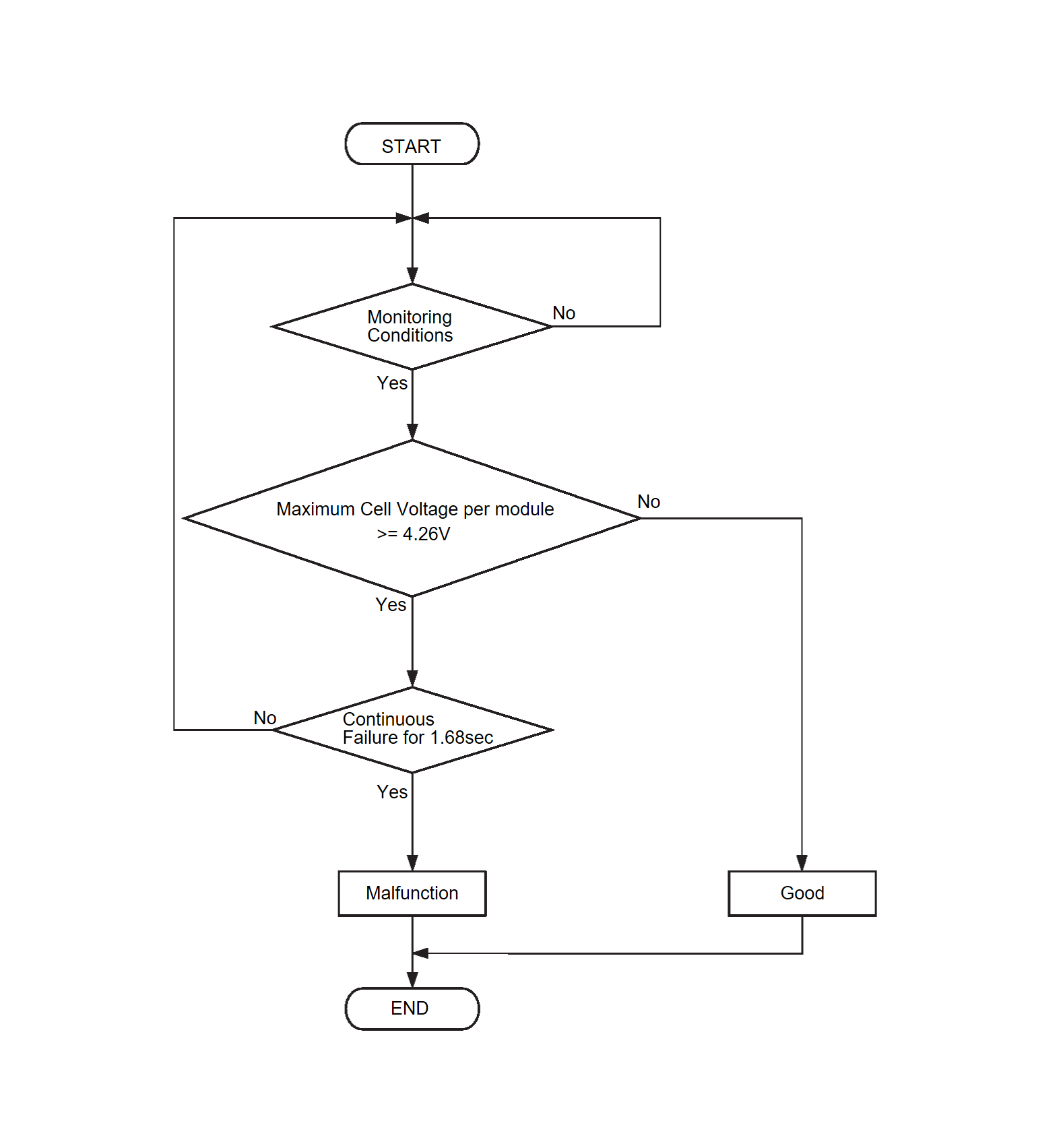DTC No. P0B2A-00 Cell Voltage Over Voltage Diagnosis (Module2)
MONITOR EXECUTION
Continuous
MONITOR EXECUTION CONDITIONS (Other monitor and Sensor)
Other Monitor (There is no temporary DTC set in memory for the item monitored below)
- BMU monitor
- Drive battery voltage sensor circuit monitor
Sensor (The sensor below is determined to be normal)
- Not applicable
Check Condition
- The BMU power supply voltage is more than 7.578 volts.
Judgment Criterion
- The maximum cell voltage of the battery module No. 2 is 4.26 volts or more for 1.68 seconds or more.
OBD-II DRIVE CYCLE PATTERN
- Refer to OBD-II Drive Cycle OBD-II DRIVE CYCLE
 .
.
TROUBLESHOOTING HINTS
- Excessive charge due to the malfunction of the high voltage components
- Malfunction of the cell voltage wiring harness
- Malfunction of the battery module No. 2
- Malfunction of the BMU
DIAGNOSIS
Required Special Tools:
- MB992744: Vehicle communication interface-Lite (V.C.I.-Lite)
- MB992745: V.C.I.-Lite main harness A
- MB992747: V.C.I.-Lite USB cable short
- MB992748: V.C.I.-Lite USB cable long
- MB991223: Wiring harness set
- MB992006: Extra fine probe
1.Check of other system DTC
Check whether the systems other than BMU and BMU2 set the DTC. Troubleshoot the set DTCs.
Troubleshoot the set DTCs.
Is the DTC set?
 Troubleshoot the set DTCs.
Troubleshoot the set DTCs.2.Check of other DTC
Check whether the BMU and BMU2 set the following DTC. Troubleshoot the set DTCs (Refer to DIAGNOSTIC TROUBLE CODE CHART
Troubleshoot the set DTCs (Refer to DIAGNOSTIC TROUBLE CODE CHART ). Then,
). Then, 
- DTC No. P0B3B-00 CC diagnosis - Common Register diagnosis (ASIC1)
- DTC No. P0B40-00 CC diagnosis - Common Register diagnosis (ASIC2)
- DTC No. P0B45-00 CC diagnosis - Common Register diagnosis (ASIC3)
- DTC No. P0B4A-00 CC diagnosis - Common Register diagnosis (ASIC4)
- DTC No. P0B4F-00 CC diagnosis - Common Register diagnosis (ASIC5)
- DTC No. P0B54-00 CC diagnosis - Common Register diagnosis (ASIC6)
- DTC No. P0B59-00 CC diagnosis - Common Register diagnosis (ASIC7)
- DTC No. P0B5E-00 CC diagnosis - Common Register diagnosis (ASIC8)
Is the DTC set?
 Troubleshoot the set DTCs (Refer to DIAGNOSTIC TROUBLE CODE CHART
Troubleshoot the set DTCs (Refer to DIAGNOSTIC TROUBLE CODE CHART ). Then,
). Then, 
3.Test the OBD-II drive cycle.
(1) Carry out a test drive with the drive cycle pattern. Refer to OBD-II Drive Cycle OBD-II DRIVE CYCLE .
.
 .
.(2) Check the DTC.
Is the DTC set?
 The trouble can be an intermittent malfunction (Refer to General Information - How to Use Troubleshooting/Inspection Service Points, How to Cope with Intermittent Malfunctions HOW TO COPE WITH INTERMITTENT MALFUNCTIONS
The trouble can be an intermittent malfunction (Refer to General Information - How to Use Troubleshooting/Inspection Service Points, How to Cope with Intermittent Malfunctions HOW TO COPE WITH INTERMITTENT MALFUNCTIONS ).
).4.Cell voltage harness check
(1) Disassemble the drive battery (Refer to SERVICE PROCEDURE ).
).
 ).
).(2) Check the cell voltage wiring harness of the battery module No. 2 (Refer to CELL VOLTAGE HARNESS CHECK ).
).
 ).
).Is the check result normal?
 Replace the cell voltage harness (Refer to SERVICE PROCEDURE
Replace the cell voltage harness (Refer to SERVICE PROCEDURE ). Then,
). Then, 
5.Battery module No. 2 check
Check the battery module No. 2 (Refer to BATTERY MODULE CHECK ).
). Replace the BMU (Refer to BATTERY MANAGEMENT UNIT (BMU) REMOVAL AND INSTALLATION
Replace the BMU (Refer to BATTERY MANAGEMENT UNIT (BMU) REMOVAL AND INSTALLATION ). Then,
). Then, 
 Replace the drive battery (Refer to DRIVE BATTERY REMOVAL AND INSTALLATION
Replace the drive battery (Refer to DRIVE BATTERY REMOVAL AND INSTALLATION ). Then,
). Then, 
 ).
).Is the check result normal?
 Replace the BMU (Refer to BATTERY MANAGEMENT UNIT (BMU) REMOVAL AND INSTALLATION
Replace the BMU (Refer to BATTERY MANAGEMENT UNIT (BMU) REMOVAL AND INSTALLATION ). Then,
). Then, 
 Replace the drive battery (Refer to DRIVE BATTERY REMOVAL AND INSTALLATION
Replace the drive battery (Refer to DRIVE BATTERY REMOVAL AND INSTALLATION ). Then,
). Then, 
6.Test the OBD-II drive cycle.
(1) Carry out a test drive with the drive cycle pattern. Refer to OBD-II Drive Cycle OBD-II DRIVE CYCLE .
.
 .
.(2) Check the DTC.
Is the DTC set?
 Retry the troubleshooting.
Retry the troubleshooting. The procedure is complete.
The procedure is complete.![[Previous]](../../../buttons/fprev.png)
![[Next]](../../../buttons/fnext.png)
